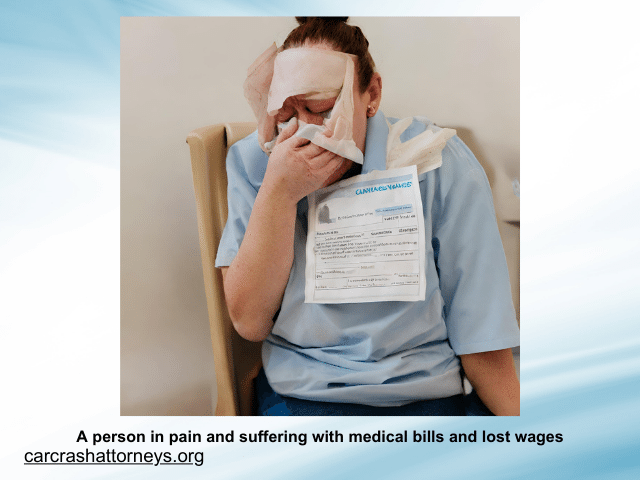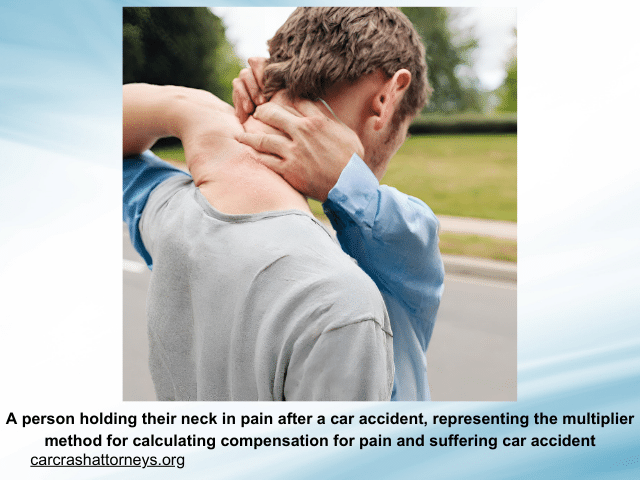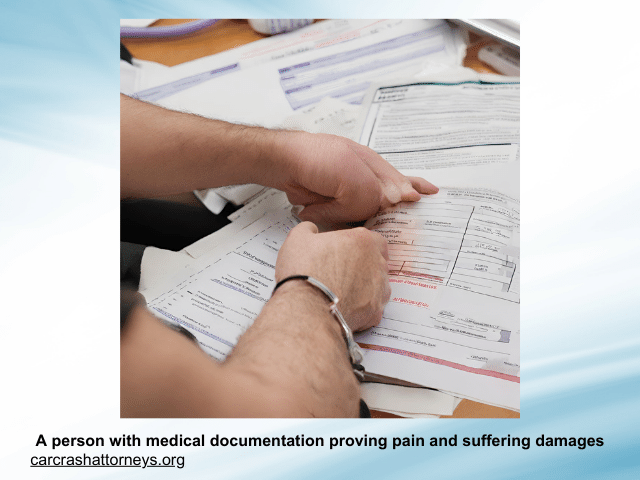How to Calculate Pain and Suffering Car Accident Claim
Imagine driving home after a long day at work when suddenly, another car crashes into yours. The pain and suffering car accident leaves you with painful injuries that require extensive treatment and time off work. On top of dealing with physical pain, you’re also facing emotional distress. How do you go about seeking compensation for your pain and suffering? Navigating the complexities of car accident claims can be overwhelming. But this blog post aims to guide you through the process. It helps you calculating and proving pain and suffering damages, ensuring you receive the compensation you deserve.
Key Takeaways
Engaging the expertise of a qualified car accident attorney is essential to understand and quantify pain and suffering damages.
Factors such as severity, duration, and long-term effects of injuries should be considered when calculating pain and suffering damages.
Working with an experienced personal injury lawyer can help ensure proper compensation is achieved through negotiation or legal action.
Understanding Pain and Suffering Car Accident Claims

Pain and suffering damages encompass all non-economic damages incurred from a car accident, reflecting the overall physical pain and emotional suffering experienced due to the negligence of another person. Engaging the expertise of a seasoned car accident attorney can help demystify what constitutes pain and suffering in your unique situation.
These damages are often difficult to quantify, making the guidance of a personal injury attorney invaluable in navigating the personal injury claim process and ensuring fair compensation.
Physical Pain and Emotional Distress
Physical pain and emotional distress are the consequences of a car accident that victims may face. The physical injuries sustained can range from minor cuts and bruises to more severe injuries, such as broken bones, disfigurement, or even permanent disabilities.
Emotional pain and suffering, including mental anguish, may encompass:
Fear
Shock
Humiliation
Grief
Depression
Anxiety
Post-traumatic stress disorder (PTSD)
The aftermath of a car accident transcends physical injuries; emotional and psychological traumas can be equally debilitating and should be considered in a pain and suffering claim.
Impact on Quality of Life
Pain and suffering can significantly affect a victim’s quality of life, impeding their capacity to undertake daily activities, psychological well-being, and general contentment. For example, an accident victim may struggle with attending work, caring for their family, or even getting out of bed in the morning.
The emotional weight of pain and suffering can also lead to:
Depression
Anxiety
Feelings of isolation
Hopelessness
Despair
These impacts on quality of life warrant consideration when pursuing suffering compensation for pain and suffering.
Factors to Consider in Calculating Pain and Suffering Car Accident Claims

Three main factors influence the calculation of pain and suffering damages: the severity of injuries, the duration of recovery, and any long-term effects such as permanent disabilities or disfigurement. Each of these factors plays a significant role in determining the pain and suffering compensation an accident victim may be entitled to receive.
A careful examination of these factors, supported by relevant evidence, is key to achieving a fair estimation of pain and suffering damages.
Severity of Injuries In Pain and Suffering Car Accident Claims
The severity of injuries is a critical factor in evaluating the value of pain and suffering damages. Studies have shown that increased injury severity is linked to greater pain and higher compensatory awards for pain and suffering in personal injury cases. For instance, a person who sustains a broken bone in a car accident may experience more pain and suffering than someone who only endures minor cuts and bruises.
To accurately assess the severity of injuries, one must consider the type of injury, the scope of the injury, the duration of recuperation, and any potential long-term repercussions.
Duration of Recovery
The duration of recovery time plays a significant role in determining the amount of pain and suffering damages awarded in a car accident claim. Generally, the longer the recovery time, the more pain and suffering damages may be awarded.
Factors that can affect the duration of recovery include the severity of the injuries, the type of treatment necessary, and the individual’s general health. Documenting the recovery duration is important as this information underpins the claim and aids in securing adequate compensation for the victim’s pain and suffering.
Long-Term Effects of Pain and Suffering Car Accidents
Long-term effects can have a lasting influence on a person’s quality of life and significantly impact the value of pain and suffering damages. These effects may include:
Permanent disabilities
Disfigurement
Chronic pain
Emotional distress
To determine the value of long-term effects, one can utilize either the multiplier or per diem method. The multiplier method involves multiplying the total medical expenses by a number ranging between 1.5 and 5, dependent on the severity of the injury.
The per diem method involves calculating the daily rate of pain and suffering and multiplying it by the number of days the injury is anticipated to last.
Common Calculation Methods for a Pain and Suffering Car Accident

The two most common methods for calculating pain and suffering damages in car accident claims are the multiplier method and the per diem method. Both methods aim to assign a monetary value to the pain and suffering experienced by the accident victim, but they approach the calculation process differently.
Understanding these methods can help ensure a fair and accurate calculation of pain and suffering damages.
Multiplier Method

The multiplier method involves multiplying the total economic damages, such as medical bills and lost wages, by a number between 1 and 5, depending on the severity of the injury. This method aims to provide a simple and straightforward way to assign a monetary value to pain and suffering damages.
Yet, selecting the appropriate multiplier can be subjective, and consulting with a personal injury attorney can aid in determining the most accurate multiplier for your situation.
Per Diem Method for Calculating Pain and Suffering Car Accident Claims
The per diem method assigns a daily value to pain and suffering damages based on the duration of the victim’s recovery. An attorney can calculate a daily rate for pain and suffering. They do this by determining the daily income of the victim, if they had not been injured..
The underlying assumption behind the per diem method is that the injured party will be restored to their pre-injury state by a predetermined time. This method allows for a more precise calculation of pain and suffering damages, but it may not be suitable for all cases, especially those with long-term or permanent effects.
Proving Pain and Suffering Damages

Proving pain and suffering damages in a car accident claim can be challenging, as these damages are often subjective and difficult to quantify. However, there are several strategies that can help support your claim, including the use of medical documentation, personal journals and statements, and expert testimony.
By providing strong evidence, you increase the likelihood of receiving fair compensation for your pain and suffering.
Medical Documentation
Medical documentation, including records and receipts, is instrumental in substantiating pain and suffering damages. These records can help illustrate the severity of an injury, the length of recovery, and the long-term consequences of an injury.
Maintaining thorough and accurate medical documentation can fortify your claim and assist the insurance adjuster or jury in comprehending the full impact of the accident on your life.
Personal Journals and Statements
Personal journals and statements from the victim and witnesses can provide invaluable insights into the impact of pain and suffering on the victim’s life. A personal journal can document your daily experiences, detailing any pain and suffering endured.
Witness statements from various individuals can help corroborate the effect of injuries on your daily life. These individuals may include:
Family members
Friends
Neighbors
Caretakers
Providing these accounts can help demonstrate the emotional and physical toll of the accident to the insurance company or jury.
Expert Testimony
Expert testimony can help support a claim for pain and suffering damages in a car accident case. Qualified experts in specific fields, such as medical professionals, can offer their professional opinion or analysis based on their knowledge, training, and experience.
This testimony can provide valuable insights into the severity of the injuries, the duration of the recovery, and the long-term effects of the accident. Presenting expert testimony can illuminate complex or technical issues relevant to your case for the court or jury, facilitating a just and informed decision.
Negotiating with Insurance Companies

Dealing with insurance companies can be a daunting task. This is especially when it comes to negotiating a fair settlement for pain and suffering damages. Insurance companies often undervalue these damages to minimize the amount of compensation paid to accident victims.
Nonetheless, adhering to certain tips and collaborating with a personal injury lawyer can enhance your prospects of securing fair compensation for your pain and suffering.
Initial Settlement Offer
The initial settlement offer from the insurance company is typically a percentage of what the insurer perceives to be the final value of the case. Accepting this offer may not be in your best interest, as it is often lower than the worth of your claim.
Engaging in negotiation over the initial settlement offer can be beneficial, potentially leading to a higher settlement amount. When negotiating, consider factors such as the severity of injuries, the duration of recovery, and the long-term effects of the accident. Also provide supporting evidence to back up your claim.
Presenting Evidence of Pain and Suffering Car Accident Claims
Offering evidence of pain and suffering damages to the insurance company is key to justifying a higher settlement amount. Provide evidence in a concise and orderly fashion. Accompany it by supporting documentation and corroborating evidence, such as medical records, personal accounts and declarations, and expert testimony.
The more compelling and well-organized your evidence, the stronger your case will be in the eyes of the insurance adjuster.
Working with a Personal Injury Lawyer
Working in tandem with a personal injury lawyer can markedly enhance your possibilities of achieving a reasonable settlement for pain and suffering damages. A skilled attorney will help you understand your legal rights and options. They provide counsel on the best course of action, and negotiate with the insurance company on your behalf.
If the insurance company does not provide fair compensation, your attorney may file a personal injury lawsuit to hold the at-fault driver responsible and ensure you receive the compensation you deserve.
Summary
Navigating the complexities of calculating and proving pain and suffering damages in car accident claims can be challenging. By understanding the factors that influence these damages, utilizing the common calculation methods, and presenting strong evidence, you can improve your chances of receiving fair compensation. Working with a personal injury lawyer can provide invaluable guidance and support throughout this process. Remember, you deserve compensation for the physical and emotional pain you have endured – don’t hesitate to seek the professional help you need to secure it.
Frequently Asked Questions for Pain and Suffering Car Accident Claims
What is the average payout for whiplash?
On average, whiplash personal injury compensation in auto tort cases is between $6,000 and $20,000. Jury verdicts for such injuries over the last five years have typically been just under $20,000.
Is there a limit to pain and suffering?
Pain and suffering damages do not have an upper limit, meaning there is no definitive answer to the question of whether there is a limit to pain and suffering.
How do you respond to a low ball settlement offer?
Remain polite and professional while asking questions and offering facts to back up your response. Formulate a counteroffer and respond in writing, ensuring not to be bullied into accepting the low settlement offer.
What injuries are hard to prove?
Pain and suffering is difficult to prove, as it is subjective and difficult to quantify. It can vary greatly from person to person, making it hard to assign a universal measure of the physical and emotional pain and suffering endured by an individual. However, there are certain methods that can be used to assess the amount of pain and suffering experienced by an individual. These include medical records, witness testimony, and other evidence that
How would you describe pain and suffering from a car accident?
Pain and suffering from a car accident refers to the physical injuries and emotional trauma resulting in loss of daily function, comfort, ability, happiness and opportunity. It covers both physical injuries, such as broken bones or whiplash, and emotional distress, such as insomnia or PTSD.
Legal Disclaimer: The content provided on carcrashattorneys.org is for general informational purposes only. It is not intended as legal advice, nor does it constitute an attorney-client relationship. The information may not be accurate, complete, or updated when viewing. Carcrashattorneys.org and its authors disclaim all liability for any actions taken or not taken based on the content of this site. Always consult with a licensed attorney in your jurisdiction before making any legal decisions. This website may contain links to other websites. We are not responsible for the content, accuracy, or opinions expressed in such websites, and such websites are not investigated, monitored, or checked for accuracy or completeness by us.


